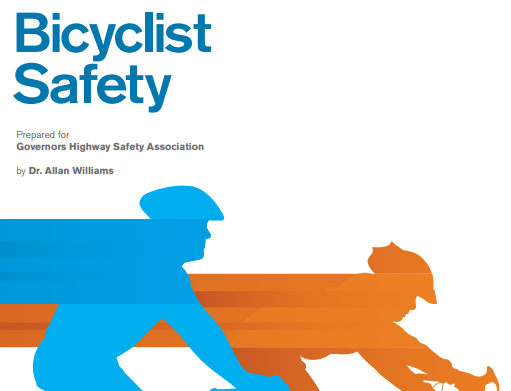
(Click for report.)
A report released by the Governors Highway Safety Association Monday is a perfect example of what can go wrong when safety experts get stuck behind their own windshields.
The GHSA, an umbrella organization for state departments of transportation whose claims to fame include popularizing the phrase “aggressive pedestrians,” is surely staffed by smart people who are working hard to reduce injuries and deaths. But the problems in this report start right at the top.
Let’s take them one by one.
The language framing the report is pointlessly divisive
Spotlight on Highway Safety: Bicyclist Safety
As Jonathan has said for years, the word “bicyclist” is silly because it’s rooted in the idea that people are monomodal — that a “bicyclist” is a fundamentally different sort of person than a “motorist.” We should all just use the word “bicycling” instead. Anybody can bicycle. (And most Americans do.)
As the headline of the GHSA press release about this report (and therefore the framing of umpteen media stories being published about it) shows, this isn’t a trivial concern:
Bicyclist Fatalities a Growing Problem for Key Groups
Adult Males and Urban Environments Now Represent Bulk of Deaths
As if fatalities among these “key groups” aren’t a problem for the rest of us, too?
Then there’s the subtitle, which gives a hint of the single biggest problem in this report…
The report makes no effort to calculate fatality rates as a share of ridership
Here’s one of the five terrifying infographics helpfully released by the GHSA, in accordance with the modern media best practice of making it easy for reporters to do their job entirely by copying and pasting.
I’m not sure why report author Dr. Allan Williams, the former chief scientist for the Insurance Institute for Highway Safety, decided to assess the risk of biking by tallying the number of times somebody died rather than considering the probability that somebody would die.
In any case, to help him out, I spent an hour looking up some figures from the 1977 and 2009 National Household Travel Surveys that might help put this report in perspective. For example, it’s possible that the increasing share of bike deaths among adults (shown in the chart above) might have something to do with this:
With a calculator we can also use Williams’s numbers to estimate the absolute number of adult bike fatalities per year:
And, oh yeah, it might be helpful to consider this:
Hey, you know what? We ought to be able to put this all together and figure out … well, what do you know.
For those of you keeping count, that’s a 43 percent decline in the risk of getting on bike.
That said, it’d be great to further reduce this risk. Let’s look at some other passages from the report.
The list of states where there are lots of bike fatalities is just a list of states where there are lots of people
The greatest numbers of bicyclist deaths occurred in high population states with many urban centers: California (338), Florida (329), Texas (143), New York (138), Illinois (80), and Michigan (72). These six states accounted for more than half (54 percent) of all bicyclist fatalities during this time period.
Here are the five most populous U.S. states: California, Texas, New York, Florida, Illinois. Michigan is ninth. I believe the webcomic XKCD has offered the definitive analysis of an “analysis” such as this.
Between 2010 and 2012, deaths increased in 22 states, decreased in 23 and D.C. and stayed the same in five. That is, less than half the states had increases in deaths over this period when deaths were increasing nationally. This is due to a few states having large increases, especially in Florida (+37) and California (+23). There were also double-digit increases in Texas (+14) and Louisiana (+12). The largest decrease was in Michigan (-10).
Okay! This is a slightly more useful observation. Here’s another way to phrase it: though bike deaths continue to become less common in most states, in the last few years they’ve become more geographically concentrated, especially in Florida, California, Texas and Louisiana.
The report dismisses the rapidly spreading installation of protected bike lanes
Roads were built to accommodate motor vehicles with little concern for pedestrians and bicyclists. Integrating motor vehicles and bicycles in already-built environments presents challenges. The most protective way to accomplish this is through total physical separation of bicycles and motor vehicles. Research confirms that “cycle paths,” which do this, provide the best safety (Teschke, 2012), but they are rarely feasible.
Williams makes a policy judgment here in the face of the fact that cycle tracks (I think that’s the phrase he was looking for) are rapidly being installed across the country as we speak. He goes on to mention bike lanes, bike boulevards, and bike-only signals as more “feasible” ways to increase bike safety.
He does not discuss the feasibility of continuing to expand auto capacity throughout the nation’s suburbs in an unending hope that the next travel lane will be the one that never fills up.
Advertisement
The report names drunk biking and biking without a helmet as major safety problems without offering evidence
Despite the association of biking with healthy lifestyles and environmental benefits, a surprisingly large number of fatally injured bicyclists have blood alcohol concentrations of 0.08% or higher. This was the case for 28 percent of those aged 16 and older in 2012, just a few percentage points lower than for passenger vehicle drivers with high BACs (33 percent). The percentage of bicyclists with high BACs has remained relatively constant from 1982 to 2012, ranging from 23 percent to 33 percent. Of note is the fact that between 1982 and 1992, the percentage of high BACs among bicyclists changed little, but dropped sharply for passenger vehicle drivers.
It’s not clear why it’s “surprising” that people involved in crashes while biking are slightly less likely to be drunk than people who are involved in crashes while driving. Absent from this section is any analysis of whether people on bikes were killed because their drunkenness led them to actually do anything wrong, or whether it impaired their ability to anticipate and avoid the illegal actions of people in cars. U.S. studies show that people are more or less equally likely to be at fault in a collision whether they’re biking or driving. (These figures, of course, rely on judgments by police, who are getting most of their information only from people who survived each crash.)
In any case, it’s true that drunk biking is generally a bad idea.
The central reason [not to require everyone to wear a helmet while biking] appears to be the concern that laws would discourage people from biking (Pless, 2014). However, the existing literature suggests that this is not the case (Dennis et al., 2010; Olivier et al., 2013), or that any drops in cycling are temporary (Finch et al., 1993; VicRoads, 2014). The lack of universal helmet use laws for bicyclists is a serious impediment to reducing deaths and injuries.
The first part of this paragraph makes a plausible argument that helmet mandates aren’t a big hassle, though it doesn’t seem to consider the global context that helmet use is rare in the countries where biking is overwhelmingly safe and popular. The final sentence in the paragraph, though, comes out of nowhere. Williams offers no evidence for the claim even though it’s subject to intense dispute among bike safety scholars.
The report does make some good points
Males age 20 and older accounted for 74 percent of all bicyclist deaths in 2012, followed by males younger than 20 (14 percent), females 21 and older (10 percent), and females younger than 20 (2 percent).
Though males outnumber females on bikes and adults outnumber children, it’s not by this much. Whatever the reason, a man is more likely to die while biking than a woman, and that’s worth knowing.
It is important that motorists be aware of bicycles not only while they are driving, but also when exiting a car to prevent opening the door on a bike. Education and law enforcement programs addressing both motorists and bicyclists have been used to encourage compliance. Appropriate and lawful behavior on the part of bicyclists and motorists would increase safety and help to reduce the tensions that can result when they share the same space. For this reason, information about relevant laws and best practices regarding bicycle and motor vehicle interactions should be covered in driver manuals, driver education courses, and written tests.
This is all true!
One state pointed out that the bicycle safety problem is “tiny” compared to alcohol, teen drivers, motorcycles, and other issues, and that there was “no justification for spending additional resources on a problem that is so small, relatively speaking.”
This useful bit of perspective is quoted by Williams without comment. It’s true that safety isn’t always the best reason to build bike infrastructure. But it’s certainly the most politically popular reason.
The report misses by far the most important story about bike safety from 1975 to 2012
Notably, current yearly deaths of bicyclists are among the lowest since 1975, when FARS data were first compiled. The highest annual total (1,003) occurred in 1975. Yearly deaths averaged 933 from 1975 to 1979, 889 in the 1980s, 792 in the 1990s, and 696 from 2000 to 2012. The 621 deaths in 2010 were the lowest in the 38 years of FARS. Motor vehicle deaths in general have decreased over this period, and the percent of deaths that are bicyclists has not increased since 1975.
For some reason, Williams decided not to put these figures on a chart. So let’s do that ourselves:
And finally — here’s what the report, once again, fails to do — let’s look at it on a per-trip basis:
OK, that’s the BikePortland Spotlight on Highway Safety: Bicycling Safety report. Any questions?
Correction 6:40 pm: An earlier version of this post overstated the risk of adult biking in 2009. (In other words, we were even more right to criticize the report than we thought we were.)
Publisher’s note: To further understand how this report isn’t just sloppy but seriously flawed from a cultural perspective, I strongly recommend reading Michael’s comment below.




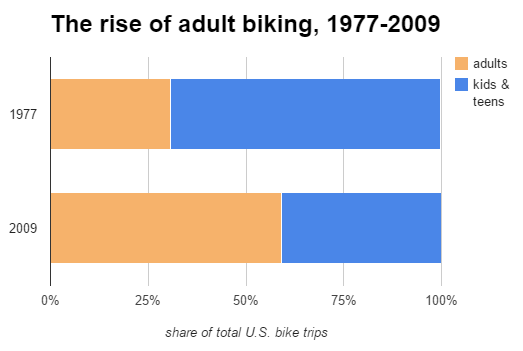
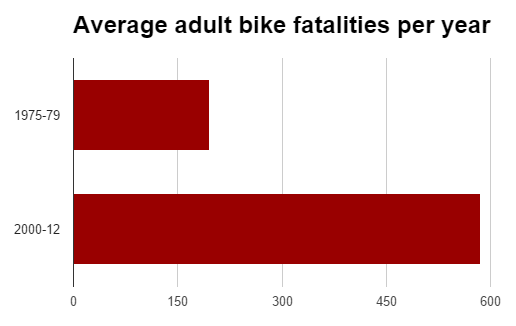
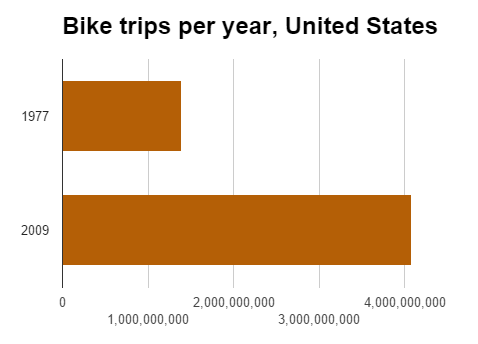
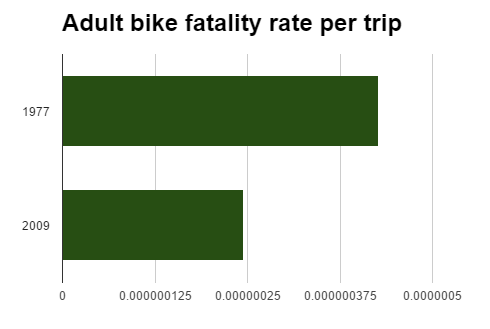
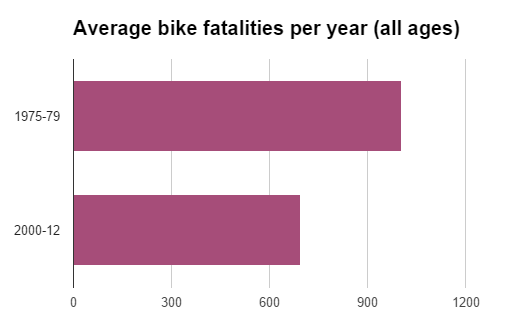
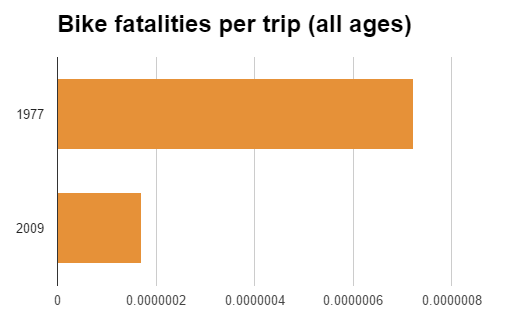
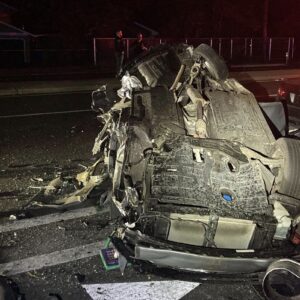


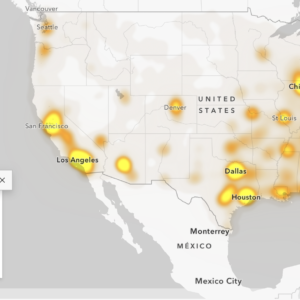
Thanks for reading.
BikePortland has served this community with independent community journalism since 2005. We rely on subscriptions from readers like you to survive. Your financial support is vital in keeping this valuable resource alive and well.
Please subscribe today to strengthen and expand our work.
Thanks for not only pointing out this report, but processing it for us. Interesting report.
GHSA’s associate members are a telling group: http://ghsa.org/html/about/assoc_members.html – nigh defines ‘confirmation bias’ and ‘car head.’
“…nigh defines ‘confirmation bias’ and ‘car head.’ ” Alan 1.0
And your response to the make up of that list, is name calling. Out of a desire it seems you have, to sustain or perpetuate a war between people biking and people driving.
Differences with terminology and semantics aside, fundamentally, the Governors Highway Safety Association seems to be interested in the safety on the road, of people using bikes for travel purposes. This is what the report is about.
Sadly, your sound and reasonable commentary wont reach far in the fight against this kind of shoddy work. But I appreciate your attention to this matter.
Maybe there’s a reason Dr. Williams no longer works for IIHS.
Well done analysis, Michael. One “action to Reduce Collisions and Injuries” that they overlooked (as does our Michigan Governor’s safety group) is modeshift. If we could shift more drivers to biking or transit and reduce VMT, crashes would reduce. We saw this during the downtown in the economy. But with motordom — both manufacturers and insurers — playing such an active role in the safety discussion, that proven countermeasure is overlooked.
Regarding drunk driving&biking, the report states: “Of note is the fact that between 1982 and 1992, the percentage of high BACs among bicyclists changed little, but dropped sharply for passenger vehicle drivers.”
This implies that DUI is on the decline for drivers, while remaining a constant problem for bikers. This had me scratching my head, not just because of their conclusion, but also why they used a 20 year old statistic for support. So I did a little digging and realized there are two very important things that occurred between 1982-92:
1. Increased usage of seat belts (which rose from 14% in 1983 to 66% in 1993 according to Wikipedia) lowers driver fatality rates in all situations including drunk driving. Bicycles do not have seat belts.
2. Congress passed the Uniform Drinking Age Act in 1984, which curtailed drinking among teenagers… a group at high risk for drunk driving fatality. I haven’t looked at the raw numbers, but I have a hunch that the majority of high BAC bicycle fatalities come from a different age group.
The GHSA report distracts us from the fact that impaired driving is still a huge problem on our highways & streets. It is true that improved safety equipment in automobiles has made it less likely that an impaired driver will die in a crash. Unfortunately, the protection provided by seat belts and airbags does not extend to the people and property that end up as “collateral damage” in these cases.
I just came back from Florida bike meeting. A researcher found the alcohol in bikers was likely from those who lost their drivers license due to drunk driving and are bicycling now.
The Teschke study cited is a horrible study. Totally biased, and completely wrong and one of the only studies (of a multitude) on cycle paths that actually claims that there is an actual improvement (as opposed to the implication of safety that attracts new riders) of safety with bike paths than without.
Not one of the paths in that study were anywhere near traffic, and they had few (most didn’t at all) traffic crossings. It’s like saying that there are fewer incidents involving cars on the Waterfront MUP than there are on the Greenways or road side paths.
It’s nothing more than Bicycle/traffic engineer pseudo-science at it’s worse (or best if you make your living on that garbage).
I agree about the Teschke study’s problems. In my own work I usually cite the Lusk study from Montreal, which compared injury rates on “comparable” streets with and without bike facilities. It found a much more modest (though meaningful) 28 percent crash reduction on protected lanes compared to streets with no bike infrastructure.
Neither of these studies, though, assesses the systemic safety benefits to everyone of increasing the number of bikes on the road, which protected infrastructure is part of doing. IMO that’s the strongest safety argument for protected lanes.
The Lusk study stripped away many accidents that occurred at intersections and cycling volume was 2.5x higher on cycle tracks versus so-called reference streets. Moreover, the bidirectional cycle tracks studied by Lusk are considered to be flawed and dangerous infrastructure in Denmark and the Netherlands.
Mikael Colville-Andersen has a good blog posting on this topic:
http://www.copenhagenize.com/2014/06/explaining-bi-directional-cycle-track.html
Yeah, I agree that bidirectional protected lanes aren’t as safe as one-direction ones, especially without signal separation.
What was Lusk’s rationale for “stripping away” injuries at intersections? I read the study last year, the Heine/Allen critiques and the back-and-forth in the journal letters, but don’t remember that aspect of the criticism.
I believe they were concerned about bias due to cross traffic injuries. I’m not sure I understand this since reference streets presumably also had cross traffic injuries.
I’m not sure I 100% buy your objection. You do have the problem whether it compares likes, but consider how a cycle path is designed. Given that intersections are known to be more dangerous, anyone with a brain would try to minimize their occurrence on a cycle path, and the ones that I use have this nice property.
A “proper” statistical comparison would be if they compared similarly useful routes. A safe cycle path that goes nowhere is not particularly interesting.
Cycle paths and cycle tracks are completely different forms of infrastructure. Most cycle tracks in north america take Danish and Dutch “best practice” and throw it in the dumpster. Cheap and dangerous separated infrastructure is evidently better than nothing but is it better than buffered and enhanced bike lanes? The experience of european nations argues otherwise.
Yes, super analysis, Michael. Are we a bit conflicted about safety, and its scary twin, danger? Everyone 8 to 80 can ride because it’s not that dangerous. In fact, let’s not wear hi-viz clothes (or a helmet?), and let’s push expectations toward an ideal where we don’t have to. And let’s not think about what the bad driver’s insurance company’s lawyer will do in court. And let’s not have downer posts about hazards and crashes (and deaths?). But we really need safer places to ride because unavoidable parts of the routes we have, and even a few people being momentarily careless while driving a car are… really dangerous.
Motor vehicle death rates have declined phenomenally for a century
http://tinyurl.com/n982lgb
thanks to a huge variety of incremental improvements. Roadway standards. Softer dashboards. Separated freeways. Seat belts. MADD. Updated roadway standards. Air bags. Trillions on infrastructure, research, and technology. ODOT guardrails getting replaced even though they are a “tiny” part of the safety picture.
http://www.oregonlive.com/commuting/index.ssf/2014/10/oregon_dot_b
ans_guardrails_tie.html
What would that look like for people on bikes or on foot?
It would look like Portland, OR. Perhaps Jonathan and Michael should consider a piece about how much safer cycling is in Portland (and SF) than in the rest of the USA…
And compared to Europe, we still have a ways to go:
http://tinyurl.com/IRTAD2011, page 15
The 2012 rider in orange looks to be riding faster and more aggressively. That could account for the higher number of fatalities.
Excellent takedown
Joe Rose and the Oregonian didn’t waste any time jumping on the fearmonger bandwagon. His headline reads “U.S. bicycle traffic deaths soar” and he adds a video of a person being injured in a collision. http://www.oregonlive.com/commuting/index.ssf/2014/10/us_bicycle_deaths_soar_the_gee.html#incart_river
Read the O for the LOLs.
Read BikePortland to be informed.
So, as the 1970s approached, both the Netherlands and the USA faced a youth bicycling safety issue. The Netherlands responded by making bicycling safer for all, and the USA responded by reducing youth bicycling.
A bicycle transforms a human into a big fast animal: the CYCLIST.
Your poor usage of substituting a gerund for a noun aside, I dislike your telling the rest of what words we ought to use.
This from a man who has drunk the feminist Kool Aid and become addicted to the nonsensical euphemism “gender” when he means “sex.”
Once again, Michael, “gender” is a grammatical term. “Sex” is a physiological term. In German girls are neuter and turnips are feminine.
Please learn to write accurately. I recommend study of elementary Latin:
First declension, feminine–terra, terrae, et. c.
Second declension, masculine–servus, servi, et. c.
Second declension, neuter–bellum, belli, et. c.
Reed College still offers courses in Latin. You could enroll.
When methodological drivel like this gets issued by official sounding groups it too often gets taken seriously.
Makes me think that some influential bicycle advocacy group should have someone on staff with a 4+ year degree in statistics so as to expertly and authoritatively discredit it.
Wish BikePortland could afford one.
Is there some professional statistician in our audience who would volunteer their time?
No offense taken here, and I’m definitely not a professional statistician, but I sorta feel like this came pretty close: it required Jonathan to identify this as a major story early in the day, for him to let me spend the afternoon on it, for me to know where to find the ridership statistics that could debunk it, for me to spend half an hour with my head tilted sideways scouring scanned PDFs from 1983 until I found the one footnote from which I could extrapolate the rest of this data, then to write it all up on deadline on the same day that the report came out, then to publish it on a site that has enough reach that it’s been (I think) the most widely cited response to the report among organizations across the country.
Thanks to the support of advertisers and readers, Jonathan’s been able to pay middle-class wages to both of us for this stuff. Frankly, that’s amazing, and I’m really grateful for the chance to be part of it as we keep looking for ways to keep expanding this little business.
Hello from Minneapolis. I think this article is extremely well done. Thank you.
Describing GHSA an “umbrella organization for state departments of transportation” is giving credit the organization doesn’t have coming. It more a self appointed group of politicians than an umbrella group for state departments of transportation. Sort of a fringe group who don’t deserve the publicity.
If you want umbrella organizations for state transportation look to AASHTO – American Association of State Highway and Transportation Officials.
TRB – Transportation Research Board
They do have official affiliations from most or all of the state DOTs, and their board is led by bureaucrats, not by politicians. That’s why I went with the language I did.
Good job Michael. Another factor apparently missing from the report (though I haven’t read it) is the riding environment associated with the different trips of adults vs. kids/teens. If I look at my own experience, the kind of places I was riding in 1977 did not encounter near the amount and aggressiveness of traffic compared to where I ride now, commuting into work. Or sometimes riding along a busy highway. I suspect a higher level of interaction with traffic characterizes adult vs. children’s trips in general. Even if it were true, which I think you have effectively dispelled, the associated conclusion “as people ride in more dangerous environments, accident rates go up,” does not seem particularly enlightening.
Corny, but here’s a suggestion: ‘Spin cranks, not stats and study results to your personal satisfaction.’
Spin stats and study results however you like. Riding a bike on the road amongst motor vehicles, is dangerous, regardless.
I try to consistently refer to people biking or driving, etc, as ‘cyclists’, ‘drivers’, etc, because, occasionally, bikeportland’s staff directly requests that people posting comments do this. That the result of people following this practice really helps much to avoid dehumanizing, or incorrectly categorizing people that ride, bike, etc, is anyone’s guess.
Maybe one of the following two statements is less harmful to people that ride, but as to their core meaning, they seem much the same:
“Bicyclist Fatalities a Growing Problem for Key Groups”
‘Fatalities of People Bicycling, a Growing Problem for Key Groups’
Thanks for the effort, Michael. No doubt you believe as strongly in your interpretation of the Governors Highway Safety Association report stats, as those that compiled the report, do in theirs. In the final analysis though, both are the same old bowl of mashed potatoes.
Have fun riding, and be safe as you can.
Wsbob, great thoughts. My favorite is actually the way you put it up top: “Riding a bike on the road amongst motor vehicles is dangerous.” Well put!
As you know, the goal of our harping on the “ist” issue, which I realize can come off as pedantic, isn’t to get (some) people to just substitute one set of language for another but to undermine the false “us”/”them” narratives that are so easily created by referring to people as “bicyclists” and “motorists.” The big problem with the “key groups” subtitle isn’t really the “ist” itself, it’s the channel of thinking that would somehow lead a public safety organization to argue that the danger of biking is a problem only for “key groups” rather than a cost to the public.
I wasn’t familiar with the GHSA’s history until this week, and I gave them the benefit of the doubt while I was writing this admittedly snarky post. Then I saw what they’d been tweeting to promote the report:
https://twitter.com/GHSAHQ/status/526751464463405056
“Unlike many hwy safety issues, bike fatalities impact only a few states. Not an issue req nat’l attn.”
https://twitter.com/GHSAHQ/status/526712547572215809
“REPORT: Bike fatalities are a growing problem for specific groups, but not an issue universally. ”
There’s enough reasonableness in this report for it to be clear that not everybody at GHSA is thinking like that. But it seems to me, based on how they chose to promote this report, that one of the central goals of this report was to frame bike fatalities as something that “other people” suffer from.
These days adults are dying, not kids, so bike safety isn’t a matter of helping innocent children.
People often bike while drunk. You, a law-abiding policymaker, would never do that.
Irresponsible people refuse to wear helmets so we should have laws to require everyone to do so.
Nobody bikes in real America, just the big Democratic cities.
States that encourage more biking are exposing themselves to lawsuits because biking is so dangerous. This is a burden on all of us law-abiding cyclists and non-cyclists.
The common thread that wraps together the sometimes incoherent statements surrounding this report is framing the people who die while biking as an “other.” I think that’d be a much easier attitude to rationalize myself into if I were accustomed to thinking of “bicyclists” as one of many special interest groups whose interests are separate and unique from the public’s at large. That’s not a channel of thought that occurs naturally when we think of “biking” simply as an activity that people sometimes decide to do.
Exactly Michael! You have described one of the central reasons why — while I know it seems minor to a lot of people — I am so persistent about the “ist” thing.
It took me a few years to wrap my head around, but finally we had an email convo about it last year and you helped me see the light.
There’s nothing in the report, verifying who of the governor members of the association, have read the report, or whether they’ve given opinions as to what extent they relate to viewpoints it may be said are presented in the report. I’ll have to double check, but I don’t think any governor is even mentioned, or quoted in the report.
It seems to me, you, and possibly others reading your bikeportland story, may be incorrectly presuming way too much about unstated goals, people involved in initiating and compiling this report may have had. Your suggesting that a central goal of this report was to categorize people that bike as “…“other people” …”, sounds like a fantasyland notion.
The report, to me, seemed kind of dry, with not much depth in exploring infrastructure ideas that could support the use of bikes as transportation, as well as recreation. It offers just the briefest overview of some of those things, page 13, for example. Nothing new in this report, that I would think governors that follow some form of the daily news, don’t already have some grasp of. Provide them with better information and ideas, rather than a bunch of statistics and graphics that may be good for cocktail party chatter, but aren’t really worth a heck of a lot otherwise.
I hope you’re right!
“Your suggesting that a central goal of this report was to categorize people that bike as ‘…“other people” …’, sounds like a fantasyland notion.”
Michael’s assertion is not necessarily based solely on the content of the report, which could be construed as unintentionally divisive and biased, but on their promotion of the report, as seen in the tweets he links to. On one hand, the content of the report seems designed to frighten people by saying how dangerous biking has become (so responsible Americans can be counted on not to do it), but on the other hand, their promotional tweets say not to worry, it’s not a big problem nationally (i.e., for the rest of us, so it shouldn’t concern you unless you’re one of “those people”).
Presenting it, ‘yes’, but doesn’t seem to me the GHSA is promoting this report. I guess people try to use tweets for all kinds of purposes, but those that Michael enclosed in his comment, don’t seem very promotional. Who is the person that even posted those GHSAHQ tweets? Find out that information before making a bunch of assumptions.
“Promotion” can be a subtle thing these days. People use social media, of which The Twitter is one example, to get the word out about all kinds of things. “Getting the word out” is one way of “promoting” something. But “Presenting”, “promoting”, “informing”, “tweeting about”, whatever you want to call it, the message of the report is that bicycling is super dangerous for “key groups”, and the message of the tweets, which are from the GHSA’s official (or as close to it as one can get) account, is that the country as a whole doesn’t really have to worry about it, since it’s only a problem for a small number of people.
I suppose one could imagine that the report alarmed so many people that the GHSA was attempting to calm people’s fears by narrowing the scope of the problem down to “not you”, but intentionally or unintentionally, the result is the same. The ultimate take-away message is that “bicycling is super dangerous if you’re one of those people that does it. But don’t worry, you don’t have to think about it if you’re not one of them”.
This message does two things: it discourages people from trying to use a bike instead of a car (at least once in a while) due to the danger, and it tells the majority of drivers, traffic engineers, law enforcement, politicians, etc. that they can carry on with business as usual and don’t have to take any action to make bicycling safer—because it’s not really that big of a problem.
At the very least the authors and the presenters/promoters/informers/tweeters of this report need to step back and take a look at the message their choice of words is sending, because the message is sent, regardless of intent. Maybe it wasn’t an orchestrated plan to stigmatize use of bicycles, but if not, the combination of the report and subsequent communications about the report was a grossly ignorant mishandling/misrepresentation of statistics and language/messaging. Let’s hope you are correct about lack of intent, and what Michael is pointing out is just a huge blunder.
Nailed it.
I may be missing something but I think the author’s point was that “cyclist” is too rigid a term for human beings who, (may be riding a bicycle at the moment, but) are actually polymodal in their transportation choices.
But you seem to revel in your deconstruction of the author’s semantics so carry on.
Seems like you folks are in denial about the dangers of riding a bike. More people riding bikes will mean more deaths. More commonly, it just means more injuries, since deaths are a lot less common.
Here in San Francisco, the city’s annual Collisions Report (page 22) tracked that reality: More people riding, more people injured:
http://www.sfmta.com/sites/default/files/Collision_report_2010_2011_000.pdf
And SF has been systematically under-counting cycling injuries, as a UC Medical Center study found almost two years ago:
http://district5diary.blogspot.com/2013/12/san-francisco-systematically-under.html
Turns out that SF has been relying on police reports and ignoring more than 1,300 cycling injury accidents treated at SF General Hospital between 2000 and 2009—and, presumably, both before and after those years.
Interestingly, the UC study found that “cyclist-only” accidents were the most under-counted, while being just as serious as “auto-versus cyclist” accidents.
“Seems like you folks are in denial about the dangers of riding a bike. More people riding bikes will mean more deaths. More commonly, it just means more injuries, since deaths are a lot less common. …” Rob Anderson
You’re thinking it ‘seems like’? Or that folks ‘are’ in denial about the dangers of riding a bike? It’s all relative, I suppose. I ride, I know it’s dangerous to do so, though some people disagree with my contention that biking, in traffic, is dangerous. I don’t want to drive, or take mass transit, or walk, all the time. So I take the risks involved in riding a bike amongst motor vehicles, not just for myself, but somewhat for everyone else as well, that should have available to them, a safe option on the road, to ride a bike for practical and recreational purposes.
Some of the time, I can take routes less used by people traveling by motor vehicle, which reduces the risk of riding a bike amongst motor vehicles. Other times, unless I’m prepared to completely relinquish use of certain roads with a bike, I’ve got to as safely as I can manage, ride a bike amongst heavy motor vehicle traffic. Fundamentally, the alternative is a loss of freedom I think the entire nation is worse for.
“Seems like you folks are in denial about the dangers of riding a bike. More people riding bikes will mean more deaths.”
Yes, but if the percent increase in people riding is greater than the percent increase in deaths, then your chances of dying from bike riding are actually smaller, even though the absolute number of deaths has indeed increased. This means bicycling has become safer, not more dangerous.
Also, perspective matters. We can claim that riding a bike is dangerous, but why? Number one answer from the Person on the Street (I would bet) is that “you could get hit by a car!” Why would I be hit by a car? “drivers are crazy these days!” So outside of extreme mountain biking or racing the “danger” of riding a bike is largely posed by drivers of cars who are in denial about the extremely serious responsibility they have as drivers to drive carefully and not run over people. A very small error on the part of an SUV driver can have expensive and deadly results. Whether you see that as an indication that everyone else better watch out, ‘cuz there’s wild SUV drivers on the loose, or that anyone who gets behind the wheel of a car better be certain they can live up to their responsibility, is a matter of perspective. Seems there’s plenty of denial to go around.
The report that’s the subject of this thread is alarmist in that death is not the most common danger for cyclists. Injury is.
From the Centers for Disease Control:
“While only 1% of all trips taken in the U.S. are by bicycle, bicyclists face a higher risk of crash-related injury and deaths than occupants of motor vehicles do. In 2010 in the U.S., almost 800 bicyclists were killed and there were an estimated 515,000 emergency department visits due to bicycle-related injuries. Data from 2005 show fatal and non-fatal crash-related injuries to bicyclists resulted in lifetime medical costs and productivity losses of $5 billion.”
http://www.cdc.gov/HomeandRecreationalSafety/Bicycle/
“… death is not the most common danger for cyclists. Injury is.”
Well, there you go then. Except that we could say that about any other activity under the sun, except maybe skydiving. I don’t know what your motivation is in attempting to point out “denial” of cycling risk. Are you hoping that more people will get scared and quit riding bikes? Do you have a genuine concern for the safety of people who ride bikes? If bike riding is so risky, what do you think needs to be done to make it less so? What are people to do in the meantime? I don’t think anyone here has claimed that riding a bike is without risk, Michael and other commenters have merely pointed out that the statistics on cyclist deaths, as reported in the GHSA report don’t quite paint the dire picture the report’s authors suggest.
I could point to the relative risks of driving and obesity, two things which seem to go hand-in-hand with avoiding the risks of riding a bike. According to the CDC, motor vehicle crash injuries cost a total of $51B in lifetime medical costs and lost productivity, while obesity-related medical costs, not counting lost productivity, amount to $147B per year.
Do the risks of bicycling in order to avoid driving and obesity outweigh the risks of driving and potential (I know there are other means of being active than riding a bike) obesity by remaining sedentary?
Even more interesting is the notion that a device that any 5-year-old can operate is somehow a death trap that will destroy all who attempt to use it.
Get a clue. If a Parkinson’s patient can use it safely, it ain’t dangerous.
https://m.youtube.com/watch?v=aaY3gz5tJSk
The UC study I linked found that “cyclist-only” accidents are just as common and just as harmful as “cyclist-versus auto” accidents. Fatalities among cyclists are relatively rare. These “cyclist-only” accidents are called “solo falls” by cycling experts like John Forester and Robert Hurst, who also say that they are much more common that accidents with motor vehicles, though the latter cause more deaths.
And the Collisions Report I linked also found that cyclists are responsible for 50% of their own injury accidents by their reckless behavior on city streets.
Does Portland have an annual study on street accidents? Maybe things are different there.
“…These “cyclist-only” accidents are called “solo falls” by cycling experts like John Forester and Robert Hurst, who also say that they are much more common that accidents with motor vehicles, though the latter cause more deaths. …” Rob Anderson
I think that most people would not place near as much significance on the occurrence of injuries through “solo falls”, as they would injuries people riding sustain from collisions with motor vehicles. People riding, have far more control over avoidance of solo falls than they do collisions with motor vehicles being driven by a person they have little direct control over.
People serving as governors of states, have big transportation decisions to deal with. They’re obligated to at least try and wisely manage the expenditure of the public’s tax money. I think things like this report, are conceived and compiled as a way to hopefully help them in doing that.
More people, more need to get from A to B. For reasons directly related to available road area on major routes, everyone driving or riding in a motor vehicle to get there, becomes less and less feasible. Bikes being a quarter to a sixth the size of most vehicles, has them representing an easily accessible, cost efficient means of maximizing road area to meet people’s travel needs. Consequently, encouragement and support of people willing and able to ride and accept the risks, including those arising from ‘solo falls’, is likely to increase.
That UC study of cycling accidents I linked—actually, my transcription of the study for my readers, since the study itself is behind a paywall—found that solo falls are both the most under-reported here and just as damaging to the cyclist as accidents with motor vehicles. Also, as the Collisions Report I linked says, cyclists in SF are responsible for half their own injury accidents because of reckless cycling behavior.
That’s why I think talking about fatalities is a red herring and that serious injury is the real problem with riding bikes.
So which one is right? Are solo falls “just as common”, or “much more common”? Also, if we stipulate that death is more harmful than injury, and collisions with autos cause more deaths than solo falls, then how can solo falls be “just as harmful”? Wouldn’t collisions with autos be clearly “more harmful”?
Again, other than “more cyclists are injured than killed each year”, what is your point in bringing up injury rates of people bicycling? What should we do about it?
My point is obvious: most cycling injury accidents are not fatal, but they often result in very serious medical consequences. That’s what the UC study found.
I of course understand that I’m pissing against the wind by making these comments to this blog. I think cycling is being radically oversold to convince the unwary and the uninformed that they too must start riding a bike to be with-it, that cycling is simply a green, win-win deal for everyone. As a consequence, many people take it up with no understanding of the dangers involved. Here in San Francisco, City Hall and the Bicycle Coalition are even encouraging children to ride bikes to school, which is doubly irresponsible.
Doctors at UCSF hospital were alarmed at the many cycling accident patients arriving in the emergency room, which is why they did the study that found that not only were these accidents very serious but that many of them were not counted under the city’s radically flawed counting system.
Here’s the NY Times story that tipped me off to the existence of the study:
http://well.blogs.nytimes.com/2013/10/21/how-safe-is-cycling-its-hard-to-say/?_php=true&_type=blogs&_php=true&_type=blogs&_r=4
Your “point” is obvious in any context, without you even having to make it. Do just about anything, and if you end up not getting away unscathed, chances are you got injured rather than killed. Below, wsbob makes an excellent point (that’s right, wsbob, you heard me…): the dangers you are so concerned are being minimized by bicycling proponents are those that anyone who has ridden a bike before already understands. Even someone who has never ridden a bike before will come to a quick understanding of these dangers the first attempt they make—which I doubt would be a commute to work in traffic.
Besides the fact that your two studies (or your interpretations of them) have subtle, but important contradictions, if you believe solo falls are the boogeyman waiting to pounce on unsuspecting bicyclists, and that deaths from collisions with cars are a “red herring”, then how can you possibly claim that encouraging kids to ride to school is any more “irresponsible” than allowing them to ride around their own block or around the paths at the local park? What is the difference between these two activities? Sounds like you’re considering something beyond “solo falls” in making your pronouncement of irresponsibility. Could it be an intrinsic understanding on your part that cars pose a more treacherous, hard-to-understand threat than solo falls? If so, then why would collisions with cars be a “red herring”?
In any case, your solution to this problem sounds more and more like “discourage people from riding, because they might get hurt. Instead, tell them how much safer it is to drive everywhere.”
Wow. I had no idea driving was so dangerous to everyone outside of my vehicle. Throw in the fact that I’m just as likely to be maimed and/or killed while driving that vehicle, and well . . . I can’t believe I’ve survived!
I HAVE FORMED AN IDEA! The one change that can make the road safer for EVERYONE:
Outlaw private motor vehicles and the whole problem seems to vanish.
Too much? I guess it might be, but it wouldn’t hurt to impound cars and permanently revoke driver’s licenses when a driver has proven themselves to be lethal.
Either way, insisting that people stop riding bikes because so many drivers are incompetent is pretty short-sighted. Especially when we start looking at pedestrian deaths (and the head injury rate that goes with them). More pedestrians die on public streets than “cyclists”. Every single one of us is a pedestrian.
Traffic death is everyone’s problem, not just “a few key groups”. Traffic death rates climb with the driving rate as pointed out by Pacific Standard recently: http://www.psmag.com/navigation/health-and-behavior/1-cause-traffic-fatalities-texting-92121/
Bike not deadly. Car deadly. Two wheel good. Four wheel kill puppy. Bike make healthy. Car make fat. Bike save space. Car block street. Bike save money. Car cost money, space, lives, health, air quality . . .
Get it?
I don’t know of anyone “insisting that people stop riding bikes.” Instead I’m saying that cycling is being oversold, with many people poorly informed about its intrinsic dangers.
You can keep insisting that cars are the primary danger to cyclists, but the cycling experts I cited—Robert Hurst and John Forester—tell us that most cycling accidents are “solo falls” that have nothing to do with motor vehicles, which is what I’m talking about.
“Bike not deadly. Car deadly. Two wheel good. Four wheel kill puppy. Bike make healthy. Car make fat. Bike save space. Car block street. Bike save money. Car cost money, space, lives, health, air quality. Get it?”
I get it. As someone once put it, “Cars create smog; bikes create smug.”
What “…intrinsic dangers…” connected with cycling, or rather, ‘biking’, would you have advocates of biking, tell people about, that from a common sense understanding, they wouldn’t already know?
Are you honestly suggesting that most people don’t realize that riding a bike involves balance, and that falling off the bike can occur without any contribution from another vehicle? I don’t think this is what you’re suggesting.
I’d say it’s certainly o.k. to advise people considering the idea of riding a bike more to meet basic travel needs, to be aware of the potential of falling off the bike, and to take precautions accordingly. People that feel, balancing a bike would be a barrier to their being able to ride safely, do have options available to them, such as trikes, and by that, of course, I’m referring to trikes that essentially are closely related in weight and performance to two wheel road bikes.
Even knowing that, all by themselves, they could fall off their bike and get injured, maybe in an extreme case, killed, I don’t believe this is even close to the main reason most people would have reservations about riding a bike to meet basic travel needs. Rationally, the main reason they would have for being anxious about, or deciding not to ride a bike as said, is danger directly posed by motor vehicle use on the road.
Cars ARE the primary danger to everybody who uses any roadway anywhere. Well over 30,000 deaths per year on US roads. Hard to imagine they’re being killed by squirrels. Or LIVESTOCK! That’s what it is! The threat of escaped sheep in urban areas is really under-reported.
Hurst and Forester ARE correct that solo bike falls are common. Of course, those aren’t actually a concern. Do you understand the difference between a bike falling over and big crashes that actually hurt people? Deadly bike injuries do not tend to be solo falls. If they were, nobody in the Netherlands would live past age 9. Cyclists and pedestrians die when they are run into by large, mismanaged vehicles, just like the other 30,000 dead people.
It’s easy to cry “smug” at a minority of people who know how harmless they are. It’s a lot harder to argue your way out of being dead fwking wrong. Cars kill. They maim. They ruin lives. The societal cost is immeasurable.
Of course, if you were somehow able to show that more cyclists and pedestrians die in traffic because of “solo falls” than those who get run down smug bay-area drivers in denial, I’d consider any factual sources you may be able to produce.
Considering, however, that the probability of a fatality on any roadway without the help of a motor vehicle ranks somewhere between winning the lottery and being shot to death by a 2-year-old, my money says you lose in advance.
The benefits of regular cycling far outweigh the risks associated with the activity, even on London’s hire bike scheme.
Instead of responding to these comments separately, I’ve posted my thoughts on my blog:
http://district5diary.blogspot.com/2014/11/the-governors-report-on-cycling-safety.html
Rob…thanks for the link. It’s been awhile, but I’ve visited your blog, and have found bikeportland to be far more user friendly, and all things considered, from the staff here, a generally more measured oversight of the discussion. Glad though, that you felt able to share your perspective on a few things at this weblog.
A “measured” discussion? Bike Portland represents the views of a special interest group.
Rob, it seems clear that like 62% of San Francisco Voters don’t share your perspective that cars and SOVs are the future of the city.
There are more motor vehicles registered in SF now than ever before as the city gentrifies. All those well-off people moving to SF aren’t likely to start riding bikes. The mayor took raising the vehicle license fee off the ballot because it wasn’t polling well, and he rescinded Sunday parking meters in the neighborhoods to pave the way, so to speak, for his big bond measure. The city itself owns 20 parking lots, a major source of revenue for the city. It’s a mixed bag but motor vehicles will still predominate on city streets.